
VATICAN CITY — On Monday, a remarkable collaboration between the Vatican and Microsoft was unveiled, showcasing a digital twin of St. Peter’s Basilica. This innovative project employs artificial intelligence to enhance the exploration of this iconic monument and aid the Holy See in managing visitor traffic and identifying preservation challenges.
This digital representation was created using 400,000 high-resolution images captured over four weeks with drones, cameras, and laser technology, all while the basilica remained devoid of visitors. The virtual replica will go live alongside two new exhibits at the site, inviting both in-person and online visitors to engage with this historic location interactively.
Brad Smith, the president of Microsoft, described the initiative at a Vatican press conference as one of the most advanced technological undertakings of its kind ever undertaken. The timing of this project is significant, as it precedes the Vatican’s upcoming Jubilee in 2025, when it anticipates welcoming over 30 million pilgrims, in addition to the usual daily footfall of around 50,000 tourists.
During the event, Pope Francis expressed his desire for everyone to feel included within the sacred space of the basilica, emphasizing its welcoming nature. As part of the new digital experience, visitors will have the option to reserve their entry times, a feature designed to streamline access to one of the globe’s most frequently visited sites, where lines often extend for hours.
Central to this initiative is the advanced photogrammetry and artificial intelligence involved in creating a detailed digital twin of St. Peter’s Basilica. This technology not only allows virtual ‘visits’ but also facilitates informed learning about the basilica’s historical context.
The ultra-detailed 3D model has been developed in partnership with digital preservation experts at Iconem, housing a staggering 22 petabytes of information, equivalent to five million DVDs’ worth of data, as noted by Smith. The technology has already demonstrated its capability to detect structural issues and signs of wear, such as cracks and missing mosaics that are undetectable by human eye, showcasing efficiency and accuracy far exceeding human analysis.
Pope Francis has previously advocated for the ethical application of AI, even urging the creation of an international treaty aimed at regulating its use. He emphasized that technology must embody human values and compassion, morality, and forgiveness to avoid potential pitfalls.
During the audience, Pope Francis expressed gratitude to the Microsoft team and the basilica’s staff, marveling at how modern technological advancements can support the spread of an ancient faith and assist in preserving a significant piece of world heritage, as the basilica prepares to celebrate its 400th anniversary in 2026.
“This house of prayer for all peoples has been entrusted to us by those who have preceded us in faith and apostolic ministry,” the Pope remarked. He highlighted the responsibility to care for this heritage, both spiritually and materially, using cutting-edge technologies as helpful tools.
While Smith did not disclose the financial details of Microsoft’s investment in the project, he referred to it as “substantial” and noted its roots in Pope Francis’ call in 2018 to convene technology companies for discussions on promoting ethically-conscious AI.
Smith also referenced Microsoft’s previous involvement in similar AI initiatives at notable sites, such as Mont Saint-Michel in France and Ancient Olympia in Greece, demonstrating the company’s commitment to preserving cultural landmarks through innovative technology.
